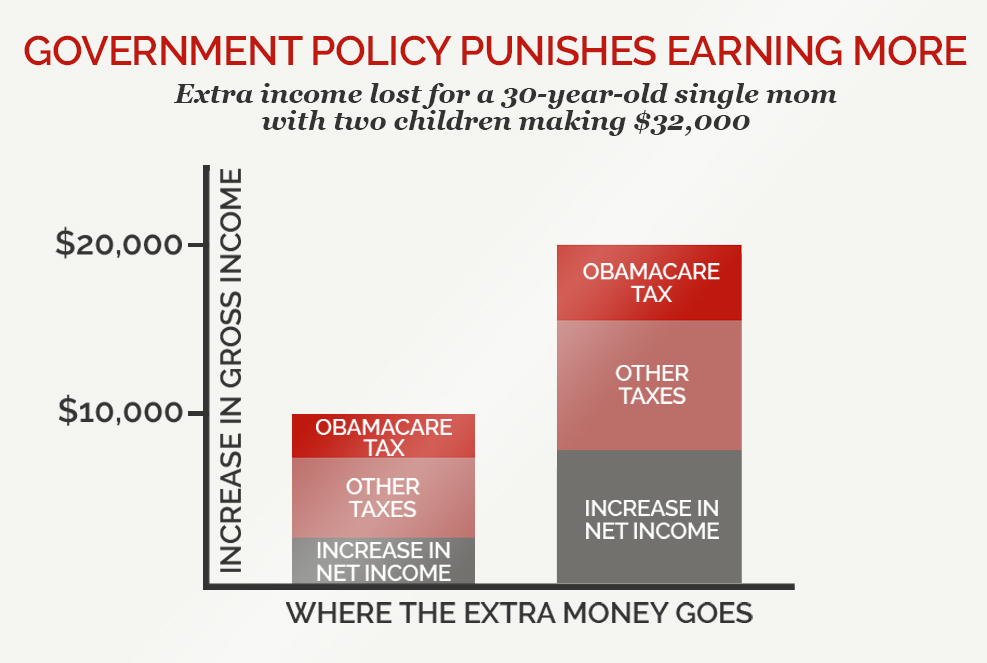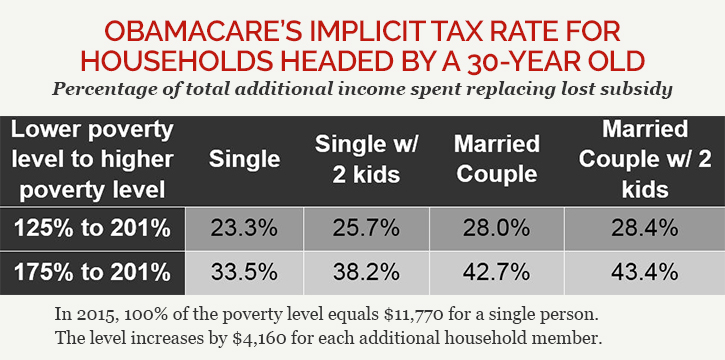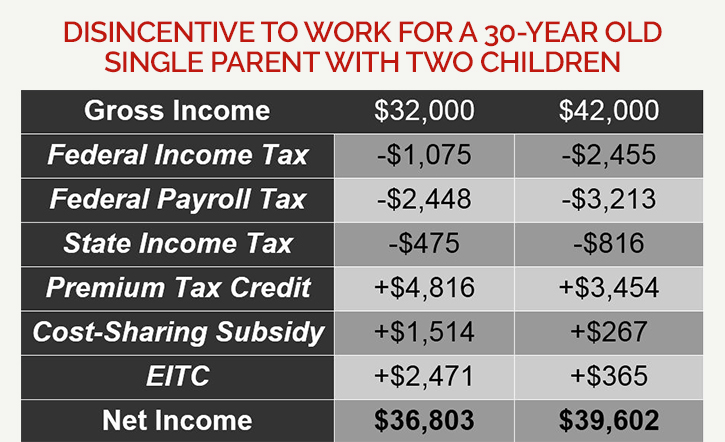Obamacare Discourages Upward Mobility
-
Obamacare discourages many people with lower incomes from earning more.
-
The additional taxes – combined with the loss of government benefits – take a substantial portion of the extra money.
-
Obstacles like these can make it harder for lower-income people to move into the middle class.
Obamacare discourages many people with lower incomes from earning more. The additional taxes – combined with the loss of government benefits – take a substantial portion of the extra money.
To see how dramatic the effect can be, consider the case of a 30-year old, single mother with two children, who earns $32,000. She hopes to move squarely into the middle class by getting a better job, paying $10,000 a year more. Today, she can qualify for an Obamacare subsidy to buy coverage. Because of how the subsidies are structured, she would lose much of her subsidy if she got the new job. Combining the loss in government program benefits with higher taxes means her family would keep less than $2,800 of the $10,000 in new income.

This 72 percent effective tax rate is a substantial deterrent for her to accept a new job with additional responsibilities or to work additional hours. Washington should be setting policies that help people move up to the middle class – Obamacare does the opposite.
Obamacare’s Implicit Tax on Work
When people decide how much to work, they compare benefits – like wages and job satisfaction – with costs – such as less leisure time and higher transportation expenses. Government policy can affect both sides of this equation. Taxes reduce the benefit that people receive from work – the higher the share of people’s wages that the government takes, the less people work.
In addition, many government programs are means-tested, so benefits decline as income rises. Government program benefit schedules often contain cliffs, in which income earned above a point results in a large benefit loss. Economists call the loss of benefits that results from more income an “implicit tax.” Like explicit taxes, these discourage people from working more.
Obamacare contains more than 20 explicit taxes that will cost Americans more than one trillion dollars over the next decade. These include excise taxes on medical devices, health insurance, and drugs, which are paid by people in the form of higher prices and less innovation. Others – such as the tax on investment income and the employer mandate – are paid by people in the form of lower economic growth, lower wages, and fewer jobs.
In addition to these explicit taxes, Obamacare contains a large implicit tax on lower-income people. This results from the design of its premium tax credits and cost-sharing subsidies. The premium tax credits are available to people with incomes between 100 and 400 percent of the federal poverty level. The amount of the credit falls as income increases.
The cost-sharing subsidies are available to people with incomes between 100 percent and 250 percent of the poverty level who purchase a silver plan. These subsidies reduce people’s costs for things like deductibles, copayments, and out-of-pocket maximums. Because of the cliffs built into the law, people get hit with large subsidy cuts if they cross thresholds at 150 percent, 200 percent, and 250 percent of the poverty level.
The implicit tax rate just from Obamacare can be substantial. How much of the total subsidy a household loses from earning extra income will vary based on things like family size. Obamacare’s average implicit tax for households in this income range is roughly 25 percent. For some families trying to move into the middle class, Obamacare’s implicit tax rate can exceed 40 percent.
The single mother with two kids, who earns $32,000, would receive $6,330 in financial assistance to purchase an Obamacare plan – $4,816 as a premium tax credit, and $1,514 as a cost-sharing subsidy. If she earns an additional $10,000, her family loses $2,609 of that assistance.
Obamacare Compounds Other Warped Incentives
Obamacare’s implicit tax is not the only one lower-income Americans face on additional work. Prior to Obamacare, the combination of explicit taxes and implicit taxes produced high effective tax rates on households earning up to double the poverty level. These people face about a 20 percent explicit marginal tax rate from income and payroll taxes. This rate is even higher if, as most economists assume, employers would pay workers more if they didn’t have to pay their share of the payroll tax.
Many households in this income range, particularly if they have children, qualify for the Earned Income Tax Credit. For people earning more than the poverty level, the EITC phases out as income increases – an extra $100 in wages reduces the EITC by about $20. Poorer households in this income range may also qualify for food stamp benefits. Combining the explicit taxes and the implicit taxes yields average effective tax rates of about 45 percent for households with two children in this income range, even without Obamacare’s sizeable implicit tax.
Look again at a single mother with two kids who is considering a new job that comes with more demands and a $10,000 raise. If we take the tax increases she would face by earning more money – including federal income and payroll taxes, typical state income taxes, and the EITC phase-out – and we add her Obamacare tax increases, we see how little her family benefits from her new job.
Her income of $32,000 puts her at 159 percent of the poverty level. After subtracting explicit taxes and adding Obamacare subsidies and the EITC, the family’s net income is $36,803. If she were to earn a salary of $42,000, she would be at 209 percent of the poverty level. At the higher salary, accounting for the same costs and benefits, her family’s net income would be $39,602. Because of the $10,000 salary increase, she pays an additional $2,486 in explicit taxes. Her family also receives $2,609 less in assistance to buy an Obamacare plan and $2,106 less from the EITC. Even though she earned $10,000 in additional income, she comes out only $2,799 ahead.
Obamacare Harms the Economy
Obamacare’s large implicit tax rates create a substantial disincentive for people to work more or to take a different job with a higher salary. It is because of incentives like these that the Congressional Budget Office projects Obamacare will reduce employment by two million full-time jobs in 2017 and by 2.5 million full-time jobs by 2024. One economist, writing in the Wall Street Journal on September 8, 2014, estimated that the damage would be twice as large. He expects Obamacare to cause a three percent drop in employment and work hours, and a two percent drop in GDP and worker income. If this prediction is correct, the total loss in worker compensation caused by the president’s health care law will exceed $2 trillion between 2017 and 2024.
Obamacare has injured millions of Americans with higher taxes, higher premiums, and less freedom. The way it penalizes people who are trying to move their families into the middle class is just one of the law’s many negative side effects. Washington should do all it can to encourage and help people trying to improve their lives. Well-designed health care reform could be a part of that by equalizing the tax treatment of health insurance rather than creating new inequities. It’s time to replace Obamacare’s disastrous incentives and get rid of another barrier that is blocking Americans from moving up into the middle class.
Next Article Previous Article


